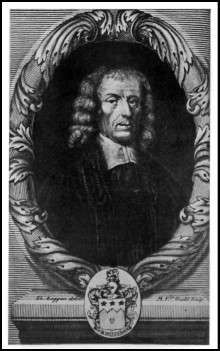Cambridge Platonists

The Cambridge Platonists were a group of theologians and philosophers at the University of Cambridge in the middle of the 17th century. The leading figures were Ralph Cudworth and Henry More.[1]
Group and its name
Mark Goldie, writing in the Oxford Dictionary of National Biography, notes that the term "Cambridge Platonists" was given in the 19th century and can be misleading. There is no clear distinction between the group and latitudinarians in general. Further, the women philosophers Mary Astell, Anne Conway and Damaris Masham were all closely related to this circle.[2]
Views
The Cambridge Platonists used the framework of the philosophia perennis of Agostino Steuco, and from it argued for moderation.[3] They believed that reason is the proper judge of disagreements, and so they advocated dialogue between the Puritan and Laudian traditions. The orthodox English Calvinists of the time found in their views an insidious attack, by-passing as it did the basic theological issues of atonement and justification by faith. Given the circle's Cambridge background in Puritan colleges, the undermining was intellectually all the more effective. John Bunyan complained in those terms about Edward Fowler, a close latitudinarian follower.[4]
Their understanding of reason was as "the candle of the Lord": an echo of the divine within the human soul and an imprint of God within man. They believed that reason could judge the private revelations of Puritan narrative, and investigate contested rituals and liturgy of the Church of England. For this approach they were called "latitudinarian".
The dogmatism of the Puritan divines, with their anti-rationalist demands, was, they felt, incorrect. They also felt that the Calvinist insistence on individual revelation left God uninvolved with the majority of mankind. At the same time, they were reacting against the reductive materialist writings of Thomas Hobbes. They felt that the latter, while rationalist, were denying the idealistic part of the universe.
To the Cambridge Platonists, religion and reason were in harmony, and reality was known not by physical sensation alone, but by intuition of the intelligible forms that exist behind the material world of everyday perception. Universal, ideal forms inform matter, and the physical senses are unreliable guides to their reality. In response to the mechanical philosophy, More proposed a "Hylarchic Principle", and Cudworth a concept of "Plastic Nature".[3]
Representatives
- Benjamin Whichcote (1609–1683)
- Peter Sterry (1613–1672)
- George Rust (d.1670)
- Henry More (1614–1687)
- Ralph Cudworth (1617–1688)
- John Smith (1618–1652)
- John Worthington (1618–1671)
- Nathaniel Culverwel (1619–1651)
- Anne Conway, Viscountess Conway (1631–1679)
- Joseph Glanvill (1636–1680)
- Damaris Cudworth Masham (1659–1708)
- John Norris (1657–1711)
Though coming later and not generally considered a Cambridge Platonist himself, Anthony Ashley Cooper, 3rd Earl of Shaftesbury (1671–1713) was much influenced by the movement.
Major works
- Benjamin Whichcote (1609–1683) was one of the leaders of the movement, but he was also an active pastor and academic who did not publish in his lifetime. His sermons were notable and caused controversies, and Whichcote wrote a great deal without publishing. In 1685, Some Select Notions of B. Whichcote was published due to demand. After that was Select Sermons (1689) (with a preface by Shaftesbury) and Several Discourses (1701). Finally, a collection of his sayings appeared as Moral and Religious Aphorisms in 1703.
- Peter Sterry is remembered for his A Discourse of the Freedom of the Will (1675) among other works.
- Henry More (1614–1687) wrote many works. As a Platonist, his important works were Manual of Ethics (1666), the Divine Dialogues (1668), and the Manual of Metaphysics (1671). While all of More's works enjoyed popularity, the Divine Dialogues were perhaps most influential.
- Cudworth's chief philosophical work was The True Intellectual System of the Universe (1678) and the Treatise concerning Eternal and Immutable Morality, which appeared posthumously in 1731.
- John Smith, a student of Benjamin Whichcote, is best remembered for the elegance of his style and the depth of his learning in the posthumously published Select Discourses (1660).
- Culverwel's chief work was Light of Nature (1652). Culverwel died young (probably at the age of 32). He had intended to write a multi-part work reconciling the Gospel with philosophical reason.
Notes
- ↑ Stuart Brown (1 May 2003). British Philosophy and the Age of Enlightenment: Routledge History of Philosophy. Routledge. p. 23. ISBN 978-0-415-30877-9. Retrieved 16 April 2013.
- ↑ Oxford Dictionary of National Biography theme "Cambridge Platonists (act. 1630s–1680s) ".
- 1 2 Hutton, Sarah. "The Cambridge Platonists". Stanford Encyclopedia of Philosophy.
- ↑ G R Cragg (March 2003). From Puritanism to the Age of Reason. CUP Archive. p. 39. ISBN 978-0-521-09391-0. Retrieved 16 April 2013.
Further reading
- C. A. Patrides. The Cambridge Platonists (Cambridge, 1980), ISBN 0-521-29942-X
External links
| Wikisource has the text of the 1911 Encyclopædia Britannica article Cambridge Platonists. |